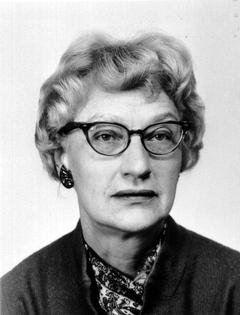Mary Haas facts for kids
Quick facts for kids
Mary Haas
|
|
|---|---|
 |
|
| Born | January 23, 1910 |
| Died | May 17, 1996 (aged 86) Alameda County, California, U.S.
|
| Education | PhD in linguistics, Yale University, 1935 |
| Alma mater |
|
| Known for | Training linguists; work in North American Indian languages; work in Thai, and historical linguistics. |
| Spouse(s) |
|
| Awards | Honorary doctorates from:
|
| Scientific career | |
| Institutions | University of California, Berkeley |
| Thesis | A Grammar of the Tunica Language (1935) |
| Doctoral advisor | Edward Sapir |
| Doctoral students | William Bright, William Shipley, Karl Teeter, Catherine Callaghan, Margaret Langdon, Terrence Kaufman, Victor Golla, Marc Okrand |
Mary Rosamond Haas (born January 23, 1910, died May 17, 1996) was an important American linguist. She studied and worked on many different languages. Her main focus was on Native American languages, the Thai language, and how languages change over time (called historical linguistics). She was also the president of the Linguistic Society of America.
Contents
Early Life and Education
Mary Haas was born in Richmond, Indiana. She went to high school and then to Earlham College in her hometown.
She earned her PhD (a high-level university degree) in linguistics from Yale University in 1935. She was only 25 years old. Her special project for her degree was called A Grammar of the Tunica Language. In the 1930s, Mary Haas worked closely with Sesostrie Youchigant. He was the very last person who spoke the Tunica language fluently. She wrote down many of his stories and words. This helped save a lot of information about the Tunica language.
Career and Research
Early Work in Language Study
Mary Haas started her advanced studies at the University of Chicago. She learned about comparative philology, which is comparing languages to see how they are related. Her teacher was Edward Sapir, a famous linguist. She followed him to Yale University.
Mary Haas spent many summers traveling to study different languages. This is called linguistic fieldwork. From 1931 to 1941, she studied several languages. These included Nitinat (a Wakashan language) and many languages from the American Southeast. Some of these were Tunica, Natchez, Creek, Koasati, Choctaw, Alabama, Cherokee, and Hichiti.
Her first published paper was about the Nitinat language. She wrote it with Morris Swadesh in 1933. Later, she worked with Watt Sam and Nancy Raven. They were the last two people who spoke the Natchez language in Oklahoma. Mary Haas wrote down a lot of information about Natchez. Her notes are now the best source of information about this language, which is no longer spoken. She also did a lot of work on the Creek language. She was the first modern linguist to collect many stories and texts in Creek.
Working at the University of California, Berkeley
During World War II, the U.S. government needed people to learn Southeast Asian languages. This was important for the war effort. Mary Haas helped create a program to teach the Thai language at the University of California, Berkeley. Her Thai-English Students' Dictionary, published in 1964, is still used today. It is considered a very important book for learning Thai.
In 1948, she became a professor at the University of California, Berkeley. She taught Thai and Linguistics. She said that Peter A. Boodberg, another professor, treated her fairly. He believed that a scholar was a scholar, no matter if they were a man or a woman. In 1953, she helped start the Department of Linguistics at Berkeley. She was also the director of the Survey of California and Other Indian Languages from 1953 to 1977. This group studied and documented many Native American languages. She retired from Berkeley in 1977. Mary Haas passed away at her home in Berkeley, California, on May 17, 1996, when she was 86 years old.
Teaching and Mentoring Students
Mary Haas was known for being a great teacher. She believed that linguists should also teach languages. Her student Karl V. Teeter said that she trained more linguists who studied Native American languages than her own teachers combined. She helped over 100 students with their fieldwork for their PhDs.
As a leader of the Survey of California and Other Indian Languages, she guided almost 50 students through their research. Many of these students became very important linguists themselves. Some of her notable students include William O. Bright (who studied Karok), William Shipley (Maidu), Victor Golla (Hupa), and Marc Okrand (Mutsun).
Personal Life
Mary Haas married Morris Swadesh, who was also a linguist, in 1931. They later divorced in 1937.
Awards and Honors
In 1963, Mary Haas became the president of the Linguistic Society of America. She received a Guggenheim Fellowship in 1964, which is a special award for people doing important research. In 1974, she was chosen as a fellow of the American Academy of Arts and Sciences. In 1978, she became a member of the National Academy of Sciences. These are very high honors for scientists. She also received special degrees called honorary doctorates from several universities. These included Northwestern University (1975), the University of Chicago (1976), Earlham College (1980), and the Ohio State University (1980).
Images for kids
See also
 In Spanish: Mary Rosamund Haas para niños
In Spanish: Mary Rosamund Haas para niños


